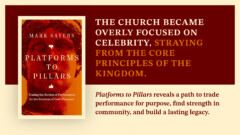I wanted A Visual History of the English Bible to be a standout. A book that I spied in a catalog and knew I just needed to read, it deals with a topic I love and in a way that is fresh and compelling. Few readers of the English Bible really understand the history of their Bible and fewer still understand the countless sacrifices that were made to bring it to us. A book like this helps us understand even more what a treasure the Bible truly is and how blessed we are to have it available to us.
In A Visual History of the English Bible, Donald Brake simply tells the story of the English Bible, beginning with the earliest pre-English Bibles and concluding with the multiplicity of modern translations. Of course he passes through John Wycliffe, Martin Luther (whose contribution to the English Bible is undoubtedly greater than most people realize), William Tyndale and his contemporaries, and of course to the men who together translated the King James Version. He pauses to describe many lesser-known Bibles, some of which have little significance but others of which shaped and influenced the translations that would follow. Though this is a topic whose books are often written for the academy, this one is clearly written for a much more general audience. The prose is informal, as reference books go, and relies little on a lexicon unique to the subject matter.
Many references books are oversized–books that are difficult to carry around and sometimes even difficult to read. This title, though, is quite a standard hardcover size. Printed throughout on glossy paper it is exceptionally heavy, but still easy enough to carry and to read. It is wonderfully illustrated in full color. Rarely will a reader go more than two pages without finding an illustration, a photograph or a sidebar containing some kind of interesting and relevant information. The illustrations portray the heroes or villains in the story or display the beautiful Bibles that have survived from antiquity. Many of the photographs even come from the author’s collection. In the sidebars the book weaves together the history of the English Bible with the author’s quest to establish his own collection of rare antique Bibles. These stories, in which we find the author traveling the world seeking to track down some great treasure, are delightfully geeky but, for that very reason, a great deal of fun. By his own admission, there is a “gentle madness” in the serious pursuit of any collectible and his obsession is readily apparent in the pages of his book. It makes for good reading.
With so much good, this book could have been a standout. Unfortunately, tragically even, the book failed to live up to its promise. I say this with great disappointment as A Visual History of the English Bible could so easily have been one of my favorite books of the year. But sadly, it is hampered by poor writing. The writing is at times mediocre and at other times–too many times–just plain bad. The author relies heavily on the passive voice and includes far too many clunky sentences. Too many times the book launches forward into the future before returning to the past, providing a time line that is very difficult to follow. The writing was such a disappointment to me, especially for a book published by Baker; it is certain atypical for a book with this kind of problem to make its way through Baker’s editorial process.
A Visual History of the English Bible is a book that oozes with potential, yet sadly, one that can’t quite live up to it (or maybe it just can’t live up to my lofty desires for it). Dogged by some poor writing, it offers great information and wonderful illustrations, but often surrounded by substandard prose. This is not to say that it is without value. The information it contains is excellent and there is much to gain from reading it. But it is sad that so much sound substance could be surrounded by so much poor style. In the hands of a good editor this book could have been a standout. But even saying that, I have little trouble recommending it as I know you’ll enjoy it, as I did, for its better qualities.










